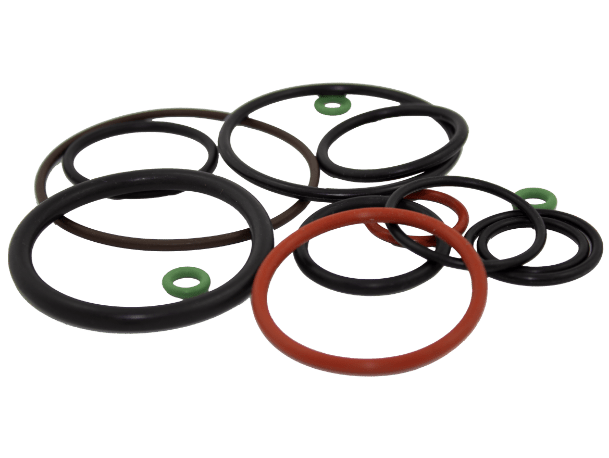In the realm of industrial engineering, where precision and reliability are paramount, one component stands out as a true unsung hero: the industrial rubber O-ring. These unassuming circular seals play a crucial role in maintaining leak-proof connections, preventing fluid or gas escapement, and ensuring the smooth operation of a wide array of machinery and systems. In this article, we’ll take a deep dive into the world of industrial rubber O-rings, exploring their composition, applications, advantages, and the key industries that rely on their exceptional sealing capabilities.
Industrial rubber O-rings are meticulously engineered components made from elastomeric materials, typically synthetic rubber compounds. The choice of rubber material is determined by the specific requirements of the application, such as temperature range, chemical compatibility, and pressure tolerance. Some commonly used rubber materials for industrial O-rings include:

-
Nitrile Rubber (NBR): Known for its excellent oil resistance, NBR O-rings are frequently used in automotive, industrial, and hydraulic systems.
-
Ethylene Propylene Diene Monomer (EPDM): EPDM O-rings excel in outdoor applications due to their exceptional weather and water resistance.
-
Viton (FKM): FKM O-rings are prized for their chemical resistance, high-temperature stability, and are commonly used in industrial and aerospace applications.
-
Silicone Rubber (VMQ): Silicone O-rings are valued for their wide temperature range, low toxicity, and are often used in medical and food-related industries.
-
Neoprene (CR): Neoprene O-rings exhibit excellent resistance to oils and chemicals, making them suitable for various industrial applications.
-
Sealing Excellence: The primary function of industrial rubber O-rings is to create a secure and dependable seal between mating surfaces. This prevents the leakage of fluids or gases, which is crucial in industries where precision and reliability are paramount.
-
Pressure and Temperature Resilience: Industrial rubber O-rings are designed to withstand a range of pressures and temperatures, making them adaptable to diverse operating conditions.
-
Chemical Compatibility: Different elastomeric materials provide varying levels of resistance to chemicals, ensuring that O-rings remain unaffected by corrosive substances commonly encountered in industrial environments.
-
Vibration and Shock Absorption: The flexibility of rubber O-rings allows them to absorb vibrations and shocks, contributing to the longevity and performance of machinery and equipment.

-
Anti Vibration Pads Manufacturer in Pune
Anti Vibration Pads Manufacturer in Pune Introduction Shende Sales Corporation established in... -
Best Quality V Rings Manufacturer
Best Quality V Rings Manufacturer We are the top rubber V-ring... -
Industrial Rubber Flat Rings | Types & Applications – Shende Sales Corporation
Shende Sales Corporation is India’s leading Industrial Rubber Flat Rings Manufacturer,...
Applications Across Industries
The effectiveness of an O-ring greatly depends on the material chosen for its construction. Different applications call for specific materials that exhibit varying levels of resistance to temperature, pressure, and chemicals. Common O-ring materials include:
-
Oil and Gas: Industrial rubber O-rings find extensive use in oil and gas exploration and production, where they seal valves, pumps, compressors, and pipelines, preventing leaks and ensuring safe operations.
-
Manufacturing and Machinery: In manufacturing and machinery, O-rings are employed in hydraulic and pneumatic systems, pumps, valves, and compressors, maintaining fluid integrity and enhancing efficiency.
-
Aerospace and Defense: Aerospace applications, including aircraft engines and critical hydraulic systems, rely on rubber O-rings to withstand extreme conditions and ensure mission success.
-
Automotive Industry: From engines to fuel systems, rubber O-rings play a pivotal role in the automotive sector, ensuring optimal performance and fuel efficiency.
-
Pharmaceuticals and Food Processing: O-rings used in these industries must adhere to stringent regulations and standards, maintaining seal integrity to prevent contamination.
Advantages of Industrial Rubber O-Rings
Cost-Effective: Rubber O-rings provide a cost-effective sealing solution, offering high performance and durability without breaking the bank.
Versatility: The wide variety of rubber materials allows for customization based on the demands of specific applications, ensuring an optimal fit.
Reliability: Industrial rubber O-rings’ ability to maintain consistent seals, even in challenging conditions, contributes to the overall reliability and longevity of equipment and systems.
Easy Installation and Maintenance: O-rings are simple to install and replace, minimizing downtime during maintenance or repairs.
Conclusion
Industrial rubber O-rings might be small in stature, but their impact on the world of engineering and manufacturing is immeasurable. These unassuming components play a pivotal role in maintaining the integrity of various systems, from heavy machinery to aerospace technology, ensuring safety, efficiency, and reliability. As industries continue to evolve and innovate, industrial rubber O-rings will undoubtedly remain a crucial cornerstone, silently ensuring the smooth operation of the machinery that powers our modern world.
Lorem ipsum dolor sit amet, consectetur adipiscing elit. Ut elit tellus, luctus nec ullamcorper mattis, pulvinar dapibus leo.


